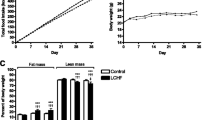Abstract
Two inbred rat strains, differing in their resistance to the induction of myocardial lesions by the administration of isoprenaline (ISO), have been developed. The extent of ISO-induced myocardial lesions (IML) was three to five times lower in the ISO-resistant (IR) strain as compared to that in the ISO-sensitive (IS) strain. The two strains differ also in a number of other genetically determined features, e.g., a higher myocardial glycogen content (MGC) and higher adipose tissue weight in IR rats. Between IML extent and MGC a significant negative correlation has been demonstrated in 2nd filial generation of IR and IS hybrids. By contrast, no correlation has been found between the resistance to the development of IML and the other genetically determined features studied. High resistance to the development of IML and a high MGC were also noted in another inbred strain, the hypertriacylglycerolemic (HTG) rats. Comparison of IML extent in HTG, IR and IS rats has revealed that the extent of IML, while depending on MGC, is independent of triacylglycerolemia.
MGC can be raised in IR and IS rats by various interventions (e.g., repeated administration of ISO or fasting). Regardless of the intervention used, it entails a simultaneous increase in resistance to the development of IML. In vivo administration of glucose and insulin, however, exerts only a minimal effect on MGC and on the extent of IML.
It may be concluded, therefore, that under our experimental conditions the enhanced resistance to the development of IML, whether genetically determined (IR, HTG rats) or induced by some interventions (fasting, repeated ISO administration), is closely related to an increased MGC.
Similar content being viewed by others
References
Buja LM, Eigenbrodt ML, Eigenbrodt EH (1993) Apoptosis and necrosis-basic types and mechanism of cell death. Arch Path Lab Med 117:1208–1214
Carr PB, Gross RW, Sobel BE (1982) Arrhytmogenic amphiphilic lipid and the myocardial cell membrane. J Mol Cell Cardiol 14:619–626
Carrol NV, Longley RW, Roe JH (1956) The determination of glycogen in liver and muscle by use of anthrone reagent. J Biol Chem 220:883–893
Chierchia SL, Fragasso G (1993) Metabolic management of ischaemic heart disease. European Heart Journal (14 suppl G): 2–3
Classen L, Michalski D, Kammermeier H (1993) Catecholamine-induced cardiac necroses: Protective effects of leucocytopenia, influence of an S2 antagonist thromboxanesynthetase inhibitor and prostacycline analogue. Basic Res Cardiol 88:52–59
Dušek J, Rona G, Cahn DS (1970) Myocardial resistance. A study of its development against toxic doses of isoproterenol. Arch Pathol 89:79–83
Fábry P, Poledne R, Kazdová L, Braun T (1968) The effect of feeding frequency and type of dietary carbohydrate on hepatic lipogenesis in the albino rat. Nutr Dieta 10:81–90
Faltová E, Mráz M, Parízková J, Šedivý J (1985) Physical activity of different intensities and the development of myocardial resistance to injury. Physiol Bohemoslov 34:289–286
Faltová E, Mráz M, Šedivý J (1983) Protective effects of isoprenaline pretreatment on the cardiotoxicity of the same drug. Physiol Bohemoslov 32:307–318
Faltová E, Pařízková J, Mráz M, Šedivý J, Špátová M (1983) Influence of motor activity on the development of isoprenaline-induced heart lesions. Physiol Bohemoslov 32:203–209
Jennings RB, Murry CE, Steenbergen CE (1990) Development of cell injury in sustained acute ischemia. Circulation 82: (Suppl II): 2–12
Lopaschuk GD, Wampolt RB, Barr RL (1993) An imbalance between glycolysis and glucose oxidation is a possible explanation for the detrimental effects of high levels of fatty acids during aerobic reperfusion of ischemic hearts. J Pharmacol Exp Therap 264:135–144
Maroko PR, Kjekshus JK, Sobel BE, Watanabe T, Cowell JW, Braunwald E (1971) Factors influencing infarct size following experimental coronary artery occlusion. Circulation 43:67–82
Mráz M, Faltová E, Lincová D, Šedivý J, Gaier N, Muhlbachová E, Černohorský M, Vrána A (1986) Genetic differences in the resistance of rats to isoprenaline-induced heart lesions. Basic Res Cardiol 81: 74–82
Mráz M, Faltová E, Sedivý J, Protivová L, Pilný J (1980) Quantitative evaluation of the development of isoprenaline-induced heart lesions Physiol Bohemoslov 29: 323–331
Mráz M, Faltová E, Vrána A, Hynie S (1994) The effect of blood free fatty acids concentration and myocardial glycogen content on isoprenaline-induced heart lesions. Prepared to press
Okamoto K, Aoki K (1963) Development of a strain of spontaneously hypertensive rats Jpn Circ J 27: 282–293
Opie LH (1993) The mechanism of myocyte death in ischaemia. Eur Heart J: 14 Suppl G: 31–33
Reimer KA, Jennings RB (1992) Myocardial ischemia, hypoxia and infarction In: Fozzard HA (ed) The Heart and Cardiovascular System Raven Press Ltd, New York, 1875–1973
Reimer KA, Jennings RB, Tatum AH (1983) Pathobiology of acute myocardial ischemic injury. Am J Cardiol 52: 72A-81A
Rona G, Chappel CI, Balasz T, Gaudry R (1959) An infarct-like myocardial lesion and other toxic manifestations produced by isoproterenol in the rat. Arch Pathol 67: 443–455
Sheuer J, Stezoski W (1970) Protective role of increased myocardial glycogen stores in cardiac anoxia in the rat. Circ Res 27: 835–849
Starec M, Mráz M, Zídek Z, Donát P, Kršiak M, Hynie S, Rašková H (1994) Genetic differences in immunomodulation, behaviour and stress-induced organ lesions. Ann N Y Acad Sci 741: 252–262
Vik-Mo H, Mjos OD (1981) Influence of free fatty acids on myocardial oxygen consumption and ischemic injury. Ann J Cardiol 48: 361–365
Vrána A, Kazdová L, Dobešová Z, Kuneš J, Křen V, Bílá V, Štolba P, Klimeš I (1993) Triglyceridemia, glucoregulation and blood pressure in various rat strains. Ann NY Acad Sci 683: 57–68
Watson NE, Cowan RJ, Ball JD (1994) Conventional radionuclide cardiac imaging. Radiol Clinics of North America, 32: 477–500
Author information
Authors and Affiliations
Rights and permissions
About this article
Cite this article
Mráz, M., Křen, V., Kršiaková, D. et al. The role of myocardial glycogen content for the development of isoprenaline-induced myocardial lesions in different inbred strains of rats. Basic Res Cardiol 90, 467–474 (1995). https://doi.org/10.1007/BF00788539
Received:
Revised:
Accepted:
Issue Date:
DOI: https://doi.org/10.1007/BF00788539



